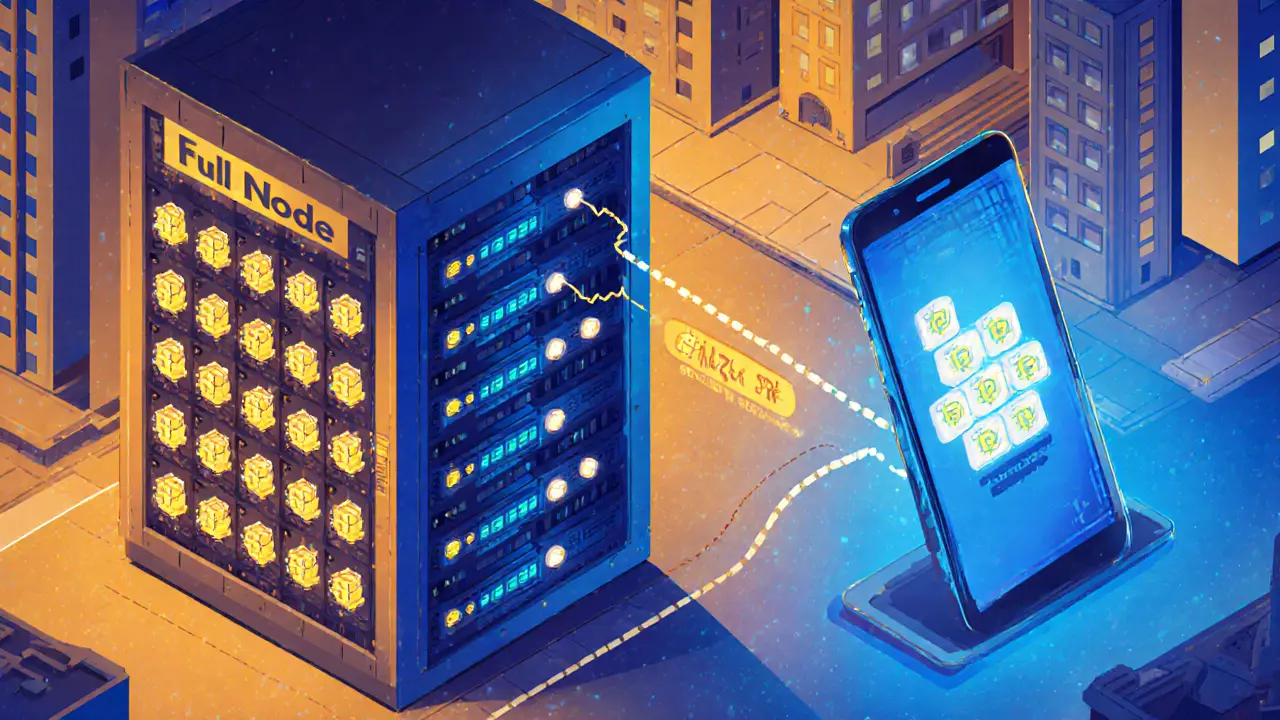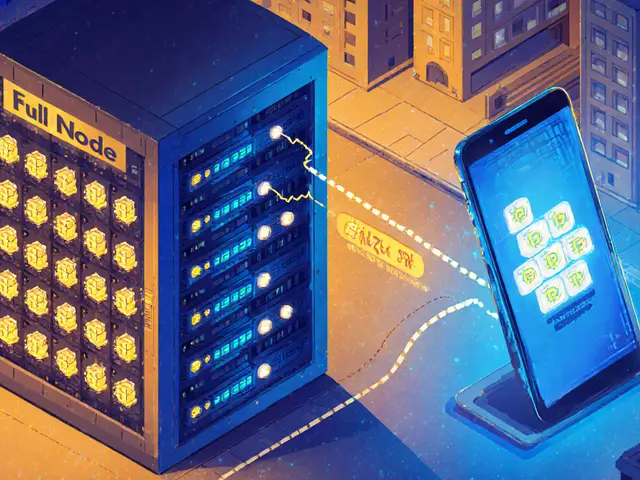Full Nodes vs Light Nodes in Blockchain: What’s the Difference?

Full Node vs Light Node Comparison Tool
Full Node
Complete blockchain validation and storage
Light Node (SPV)
Minimal storage with trust-based validation
Key Comparison Features
Full Node Characteristics
- Storage: Hundreds of GBs (grows over time)
- Validation: Full validation of all transactions
- Security: Highest security through independent verification
- Performance: Higher latency, more CPU usage
- Use Cases: Infrastructure, mining, analytics
Light Node Characteristics
- Storage: Few MBs to a few hundred MBs
- Validation: Validates only transactions via proofs
- Security: Relies on honesty of full nodes
- Performance: Faster startup, lower CPU load
- Use Cases: Mobile wallets, IoT devices
Decision Guide
Choose Full Node If:
- You need independent verification of every transaction
- You're building infrastructure or running validators
- You require access to historical data for analytics
- Storage and CPU are not limiting factors
Choose Light Node If:
- Storage or CPU is limited (mobile, IoT)
- You want faster startup times
- You're building consumer-facing applications
- Bandwidth usage is a concern
Quick Facts
Bitcoin Full Node
- Storage: ~380 GB (as of 2025)
- Sync Time: Several days to weeks
- Hardware: Dedicated server or high-end desktop
Bitcoin Light Node
- Storage: ~80 MB header chain
- Sync Time: Seconds to minutes
- Hardware: Smartphone or tablet
Ever wondered why some wallets need a handful of megabytes while others store hundreds of gigabytes? The answer lies in the type of node they run. Understanding the trade‑offs between full nodes and light nodes helps you pick the right balance of security, speed, and resource usage for any blockchain project.
What Is a Full Node?
Full Node is a network participant that downloads, stores, and validates the entire blockchain ledger from the genesis block onward. By keeping a complete copy of every block and transaction, a full node can independently verify the integrity of the chain without trusting anyone else. Typical implementations include Bitcoin Core for Bitcoin and Geth or Parity for Ethereum. Running a full node requires several hundred gigabytes of storage (over 300GB for Bitcoin as of 2020) and a decent CPU to process incoming data.
What Is a Light Node (SPV)?
Light Node, also called a Simplified Payment Verification (SPV) node, stores only the block headers - tiny pieces of data that contain the previous‑block hash, timestamp, and Merkle root. Instead of validating every transaction, a light node asks full nodes for proof that a particular transaction is included in a block. This design makes SPV nodes ideal for smartphones, tablets, and IoT devices where storage and CPU are limited. Light‑node clients such as Electrum for Bitcoin or MetaMask’s mobile version for Ethereum demonstrate this approach.
Core Differences at a Glance
| Aspect | Full Node | Light Node (SPV) |
|---|---|---|
| Data Stored | Entire blockchain (all blocks, transactions, state) | Only block headers (≈ 80bytes per block) |
| Storage Needed | Hundreds of GB (grows over time) | Few MBs to a few hundred MBs |
| Validation Scope | Full validation of every transaction & smart contract | Validates only transactions it cares about via proofs from full nodes |
| Security Model | Highest security - independent verification | Relies on honesty of connected full nodes |
| Performance | Higher latency, more CPU usage | Faster startup, lower CPU load |
| Typical Use Cases | Infrastructure, mining pools, block explorers, analytics | Mobile wallets, browser‑based dApps, IoT sensors |
Storage and Resource Requirements
Full nodes must allocate space for the ever‑growing ledger. For example, the Bitcoin blockchain reached 380GB in early 2025, while an Ethereum archive node can exceed 15TB because it preserves every historical state. Running such nodes typically demands a dedicated server or high‑end desktop, plus a reliable internet connection.
Light nodes, by contrast, need only enough storage for the header chain - roughly 80bytes per block. Even after a decade of Bitcoin blocks, the header chain is under 80MB. This tiny footprint lets developers embed blockchain connectivity directly into mobile wallets or low‑power IoT devices without external storage.
Validation Capabilities and Security
A full node validates every rule encoded in the consensus protocol: transaction signatures, double‑spends, block difficulty, and smart‑contract execution results. This exhaustive verification creates a strong security guarantee because the node does not trust any upstream source.
Light nodes, however, cannot perform full validation. They trust the Merkle proof returned by a full node that a transaction appears in a block. If the full node is malicious, it could feed false data. To mitigate this, most light‑node implementations connect to multiple full nodes and compare responses, reducing the risk of a single point of failure.
Performance and Efficiency
Because they handle fewer bytes and run lighter cryptographic checks, light nodes start up in seconds and consume far less CPU power. This efficiency translates to smoother user experiences on smartphones, where battery life matters.
Full nodes, while slower to sync, become the backbone of the network. Their heavy lifting ensures that blocks propagate correctly and that consensus remains intact. In Proof‑of‑Work (PoW) systems like Bitcoin, miners are special full nodes that also solve hashing puzzles. In Proof‑of‑Stake (PoS) systems such as Ethereum's Beacon Chain, validators are full nodes that stake tokens and sign block proposals.
Typical Use Cases
- Full Node Applications
- Running a public or private blockchain network - you need full nodes to enforce consensus.
- Operating a mining pool - miners submit work to full nodes that verify block eligibility.
- Providing blockchain data services - exchanges and analytics firms query full nodes for accurate, up‑to‑date information.
- Running an archive node - essential for block explorers that show historical state changes.
- Light Node Applications
- Mobile wallets (e.g., Trust Wallet, MetaMask Mobile) that let users check balances without downloading the whole chain.
- Browser‑based dApps that interact with the network via light clients like Light Ethereum Subprotocol (LES).
- IoT sensors that record transactions on a supply‑chain ledger while conserving power.
- Archive Nodes
- Specialized services for developers needing quick access to historical states, such as The Graph or Infura’s archive endpoints.

How Nodes Communicate in the Network
Full nodes maintain dozens of peer‑to‑peer connections, broadcasting newly mined blocks and received transactions. Light nodes, however, adopt a client‑server style: they open connections to a handful of trusted full nodes, request specific headers or proofs, and close the session when done. This asymmetry reduces bandwidth for light clients but also means they must manage a list of reliable peers.
Choosing the Right Node for Your Project
When deciding between a full or light node, ask yourself these questions:
- Do you need independent verification of every transaction? If yes, go full.
- Is storage or CPU a limiting factor? If yes, a light node is the practical choice.
- Will you contribute to consensus (mining or staking)? Full nodes are required.
- Do you need historical data for analytics? Consider an archive node.
- Can you trust external full nodes? If you’re building a consumer app, you often must, so design fallback mechanisms.
For most consumer‑facing products-mobile wallets, gaming dApps, or IoT gateways-light nodes strike the right balance. Enterprises building infrastructure, compliance services, or running validators should allocate resources for full nodes.
Future Trends
Researchers are narrowing the security gap between full and light clients. Protocols like Nimbus propose “stateless” validation where nodes only keep recent state snapshots, reducing storage needs without sacrificing security. Layer‑2 solutions (e.g., rollups) also offload much of the transaction processing from full nodes, meaning future full nodes may handle far fewer data while still securing the base layer.
On the light‑client side, advances in cryptographic proofs-such as zk‑SNARKs and Verkle trees-allow a light node to verify large chunks of state with a single proof, boosting trust without pulling massive amounts of data.
Frequently Asked Questions
Do I need a full node to use Bitcoin?
No. Most users run light wallets that rely on full nodes for verification. However, if you want maximum security and independence, running a full node is the best practice.
Can a light node participate in staking?
Generally, staking requires a full validator node because the protocol needs to verify and propose blocks. Light clients can delegate staking to a full node but cannot act as validators themselves.
What’s the biggest downside of running a full node?
The main drawbacks are storage consumption, bandwidth, and continuous CPU usage for synchronization. Over time, hardware upgrades become necessary.
How many full nodes does the Bitcoin network have?
Estimates vary, but public data from 2024 suggests around 10,000 reachable Bitcoin full nodes worldwide, with many more hidden behind firewalls.
Is an archive node the same as a full node?
All archive nodes are full nodes, but not all full nodes are archive nodes. Archive nodes retain every historic state, which is useful for analytics and block explorers.

Ken Pritchard
Hey folks, great breakdown! Full nodes are like the backbone of any blockchain, giving you the freedom to verify everything yourself. If you’re tinkering with a new dApp, starting with a light node can speed up dev cycles, but don’t forget to spin up a full node for final testing. It’s all about balancing resources and trust, and you’ve laid out the trade‑offs nicely.
Liam Wells
While the article presents a tidy dichotomy, one must recognize that the binary classification is, frankly, oversimplified; the nuance of hybrid nodes, for instance, is glaringly omitted, and the conclusion that light clients are merely “trust‑based” is a mischaracterization of contemporary SPV advancements. Moreover, the emphasis on storage metrics ignores the evolving landscape of sharding protocols, which could render the storage argument moot. In short, the piece neglects the middle ground and thus skews perception.
Caleb Shepherd
Alright, let’s dive in! Full nodes are the real MVPs-nothing beats the peace of mind you get when you verify every block yourself, especially when the shadowy “big players” might be trying to pull the rug out from under us. Light nodes are handy for phones, but remember, they’re only as good as the full nodes they trust, and those can be compromised if the network’s under attack. Keep your eyes peeled, stay curious, and maybe run a full node at home to double‑check the fun stuff.
Moses Yeo
One could argue that the whole full‑versus‑light debate is an artifact of legacy design, a relic of a time when bandwidth was scarce; today, with verifiable computation on the horizon, the distinction blurs. If we accept that truth can be attested via succinct proofs, the reliance on “trust” becomes a philosophical illusion rather than a technical necessity. Thus, presenting the two as mutually exclusive is, in my view, a rhetorical convenience rather than a technological inevitability.
Debra Sears
I appreciate the thorough comparison-it really clarifies the trade‑offs. It makes me wonder, though, how the emerging zero‑knowledge rollups will affect the storage requirements for full nodes. If rollups compress transaction data so effectively, perhaps the storage gap won’t be as wide as it is now. Still, keeping an eye on bandwidth usage remains crucial for any deployment.
Matthew Laird
Reading this, I’m reminded that a strong nation needs strong infrastructure, and full nodes are the backbone of that security. Relying on light clients alone is like letting strangers guard your borders; you need your own validators to ensure sovereignty. If we’re serious about protecting our digital assets, we must invest in full‑node deployments, not just outsource trust to foreign servers.
Mark Fewster
Thanks for laying out the facts clearly. The distinction between resource usage and security is especially important for newcomers. I’d add that regular backups of the blockchain data can mitigate some of the downtime concerns for full‑node operators.
Jack Stiles
Yo, that was a solid run‑down! If u wanna test stuff quick, light nodes are perfect, but when u need the real deal, go full. Gonna try spinning up a Bitcoin full node this weekend, see how it feels.
Ritu Srivastava
It’s unacceptable that many developers ignore the security ramifications of using light nodes as a default. We must champion full‑node adoption to safeguard user funds and uphold the ethos of decentralization, not surrender to convenience at the cost of trust.
Jason Wuchenich
Great summary! For anyone just starting out, I’d recommend experimenting with a light node first to get comfortable, then graduate to a full node once you’ve built confidence. It’s a steady path that keeps the learning curve manageable.
Sal Sam
From a protocol‑engineer’s perspective, the trade‑off matrix you outlined aligns with the consensus layer’s throughput versus finality latency considerations. Light clients leverage Merkle‑Mountain‑Range proofs, which, while lightweight, impose a trust assumption that must be mitigated via multi‑path redundancy. In production, we often employ a hybrid approach to balance bandwidth constraints with verification guarantees.
Lara Decker
Honestly, the article glosses over the fact that light nodes can be a vector for eclipse attacks; developers need to be wary, not just accept the “convenient” narrative presented here. Moreover, the performance claims omit the overhead of frequent header verification against multiple peers, which can degrade user experience.
Anna Engel
Ah, the age‑old debate-because obviously, the universe revolves around whether you store a few megabytes or a few hundred gigabytes. If you’re a true blockchain sage, you’ll realize that the real issue is not storage, but the metaphysical burden of trusting anyone at all.
Marcus Henderson
In the grand tapestry of distributed ledger technology, the dichotomy between full and light nodes embodies a deeper dialectic between autonomy and interdependence. While full nodes epitomize self‑sufficiency, light nodes reflect a pragmatic concession to material constraints, fostering broader accessibility without sacrificing the foundational consensus.
Andrew Lin
Look, if you’re not running your own full node, you’re basically letting foreign servers pull the strings on your crypto! It’s a disgrace to our digital freedom. Get a proper rig, download the whole chain, and stop being dependent on some overseas service. This is how we keep the nation’s crypto strong.
Richard Bocchinfuso
i think we should all try to run a full node at least once, it’s kinda like being part of the club. dont be lazy, get that storage space and do it.
Don Price
It is a well‑known fact among the privy few that the push for light clients is not merely a matter of convenience, but a calculated maneuver orchestrated by the hidden hands that profit from centralized oversight; they understand that a populace lulled into a false sense of security, believing that a lightweight interface suffices, is far easier to manipulate. The narrative that “storage is expensive” conveniently diverts attention from the real agenda-consolidating validation power into a handful of opaque farms. Moreover, every time a light client queries a full node, it entrusts a fragment of its trust to an entity that may be compromised, surveilled, or even directly compromised by state actors. The cryptographic proofs offered by SPV systems, while elegant on paper, rest upon assumptions that these full nodes are honest, an assumption that history has repeatedly proven to be fragile. Think about the 2023 incident where a major mining pool was revealed to be feeding falsified Merkle proofs to a suite of wallet apps, causing temporary chaos that was quickly swept under the rug. If a full node landscape is dominated by a few jurisdictions, the geopolitical leverage they wield over digital assets is immense, allowing them to freeze, censor, or even reverse transactions under the guise of “network maintenance.” This is why the article’s benign tone about light nodes feels disconcertingly naive; it sidesteps the existential risk of entrusting sovereignty to a distributed yet controllable network. The underlying technology, while decentralized in theory, is susceptible to centralization pressures that manifest through bandwidth throttling, selective node propagation, and the subtle incentivization of nodes that opt into low‑cost, low‑security modes. Furthermore, the proliferation of “light‑only” wallets creates a data vacuum for researchers who wish to perform forensic analysis, effectively blinding the community to potential attacks. In short, the convenience afforded by light nodes is a Trojan horse, delivering a payload of surveillance and control while masquerading as user‑friendly innovation. As we approach the next wave of blockchain adoption, it is imperative to recognize that the trade‑off is not merely between storage and speed, but between freedom and subjugation, and that the latter is far more costly than any gigabyte of data.
Dawn van der Helm
Love the clear comparison! 🎉 It really helps newcomers decide which path to take. Keep up the good work! 🚀
Monafo Janssen
Nice work! It’s cool to see the differences laid out so simply. I think more people will try running a node now.
Michael Phillips
The analysis touches on the philosophical underpinnings of trust versus autonomy. By examining the trade‑offs, we can better align our infrastructure choices with our ideological goals. It’s a useful framework for any developer.
Jason Duke
Fantastic article-exactly the kind of guide we need! Let’s all grab our hardware, fire up full nodes, and show the world that decentralization isn’t a myth!!! This is our moment to prove the skeptics wrong, and I’m all in!!!
Bryan Alexander
That’s the most epic showdown between nodes ever.
Patrick Gullion
Sure, full nodes sound great, but most people don’t have the patience to sync weeks of data; light nodes keep the ecosystem moving.
Nicholas Kulick
Solid overview; useful for anyone deciding between full and light implementations.